182 books about Space Science and 21
start with P
182 books about Space Science and 21
182 books about Space Science
21 start with P start with P
21 start with P start with P

The People's Spaceship
NASA, the Shuttle Era, and Public Engagement after Apollo
Amy Paige Kaminski
University of Pittsburgh Press, 2023
When the Apollo 11 astronauts returned from humanity’s first voyage to the moon in 1969, NASA officials advocated for more ambitious missions. But with the civil rights movement, environmental concerns, the Vietnam War, and other social crises taking up much of the public’s attention, they lacked the support to make those ambitions a reality. Instead, the space agency had to think more modestly and pragmatically, crafting a program that could leverage the excitement of Apollo while promising relevance for average Americans. The resulting initiative, the space shuttle, would become the centerpiece of NASA human space flight activity for forty years, opening opportunities for the public to engage with and participate in space projects in new ways. The People’s Spaceship traces how and why NASA painstakingly connected the vehicle to so many segments of society. Underscoring the successes and challenges endured in the process, Amy Paige Kaminski shares the story of how the space shuttle became an American technological icon.
[more]
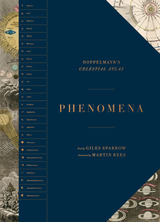
Phenomena
Doppelmayr's Celestial Atlas
Giles Sparrow
University of Chicago Press, 2022
Lavishly illustrated volume revealing the intricacies of a 1742 map of the cosmos.
The expansive and intricate Atlas Coelestis, created by Johann Doppelmayr in 1742, set out to record everything known about astronomy at the time, covering constellations, planets, moons, comets, and more, all rendered in exquisite detail. Through stunning illustrations, historical notes, and scientific explanations, Phenomena contextualizes Doppelmayr’s atlas and creates a spectacular handbook to the heavens.
Phenomena begins by introducing Doppelmayr’s life and work, placing his extraordinary cosmic atlas in the context of discoveries made in the Renaissance and Enlightenment and highlighting the significance of its publication. This oversized book presents thirty beautifully illustrated and richly annotated plates, covering all the fundamentals of astronomy—from the dimensions of the solar system to the phases of the moon and the courses of comets. Each plate is accompanied by expert analysis from astronomer Giles Sparrow, who deftly presents Doppelmayr’s references and cosmological work to a modern audience. Each plate is carefully deconstructed, isolating key stars, planets, orbits, and moons for in-depth exploration. A conclusion reflects on the development of astronomy since the publication of the Atlas and traces the course of the science up to the present day. Following the conclusion is a timeline of key discoveries from ancient times onward along with short biographies of the key players in this history.
The expansive and intricate Atlas Coelestis, created by Johann Doppelmayr in 1742, set out to record everything known about astronomy at the time, covering constellations, planets, moons, comets, and more, all rendered in exquisite detail. Through stunning illustrations, historical notes, and scientific explanations, Phenomena contextualizes Doppelmayr’s atlas and creates a spectacular handbook to the heavens.
Phenomena begins by introducing Doppelmayr’s life and work, placing his extraordinary cosmic atlas in the context of discoveries made in the Renaissance and Enlightenment and highlighting the significance of its publication. This oversized book presents thirty beautifully illustrated and richly annotated plates, covering all the fundamentals of astronomy—from the dimensions of the solar system to the phases of the moon and the courses of comets. Each plate is accompanied by expert analysis from astronomer Giles Sparrow, who deftly presents Doppelmayr’s references and cosmological work to a modern audience. Each plate is carefully deconstructed, isolating key stars, planets, orbits, and moons for in-depth exploration. A conclusion reflects on the development of astronomy since the publication of the Atlas and traces the course of the science up to the present day. Following the conclusion is a timeline of key discoveries from ancient times onward along with short biographies of the key players in this history.
[more]
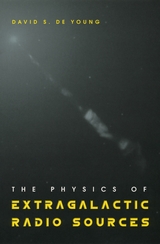
The Physics of Extragalactic Radio Sources
David S. De Young
University of Chicago Press, 2002
Extragalactic radio sources are among the most unusual and spectacular objects in the universe, with sizes in excess of millions of light years, radiated energies over ten times those of normal galaxies, and a unique morphology. They reveal some of the most dramatic physical events ever seen and provide essential clues to the basic evolutionary tracks followed by all galaxies and groups of galaxies.
In The Physics of Extragalactic Radio Sources, David De Young provides a clearly written overview of what is currently known about these objects. A unique feature of the book is De Young's emphasis on the physical processes associated with extragalactic radio sources: their evolution, their environment, and their use as probes to solve other astrophysical problems. He also makes extensive use of the large amount of data now available from observations at x-ray, optical, and radio wavelengths to illustrate his main points.
The Physics of Extragalactic Radio Sources will be a comprehensive introduction to the field for graduate students and a useful summary for astrophysicists.
In The Physics of Extragalactic Radio Sources, David De Young provides a clearly written overview of what is currently known about these objects. A unique feature of the book is De Young's emphasis on the physical processes associated with extragalactic radio sources: their evolution, their environment, and their use as probes to solve other astrophysical problems. He also makes extensive use of the large amount of data now available from observations at x-ray, optical, and radio wavelengths to illustrate his main points.
The Physics of Extragalactic Radio Sources will be a comprehensive introduction to the field for graduate students and a useful summary for astrophysicists.
[more]

Placing Outer Space
An Earthly Ethnography of Other Worlds
Lisa Messeri
Duke University Press, 2016
In Placing Outer Space Lisa Messeri traces how the place-making practices of planetary scientists transform the void of space into a cosmos filled with worlds that can be known and explored. Making planets into places is central to the daily practices and professional identities of the astronomers, geologists, and computer scientists Messeri studies. She takes readers to the Mars Desert Research Station and a NASA research center to discuss ways scientists experience and map Mars. At a Chilean observatory and in MIT's labs she describes how they discover exoplanets and envision what it would be like to inhabit them. Today’s planetary science reveals the universe as densely inhabited by evocative worlds, which in turn tells us more about Earth, ourselves, and our place in the universe.
[more]
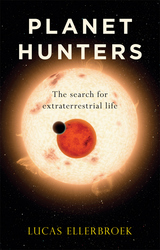
Planet Hunters
The Search for Extraterrestrial Life
Lucas Ellerbroek
Reaktion Books, 2017
Astronomers are on the verge of answering one of our most profound questions: are we alone in the universe? The ability to detect life in remote solar systems is at last within sight, and its discovery—even if only in microbial form—would revolutionize our self-image. Planet Hunters is the rollicking tale of the search for extraterrestrial life and the history of an academic discipline.
Astronomer Lucas Ellerbroek takes readers on a fantastic voyage through space, time, history, and even to the future as he describes the field of exoplanet research, from the early ideas of sixteenth-century heretic Giordano Bruno to the discovery of the first exoplanet in 1995 to the invention of the Kepler Space Telescope. We join him on his travels as he meets with leading scientists in the field, including Michel Mayor, who discovered the first exoplanet, and Bill Borucki, principal investigator for NASA’s Kepler mission. Taken together, the experiences, passion, and perseverance of the scientists featured here make the book an exciting and compelling read.
Presenting cutting-edge research in a dynamic and accessible way, Planet Hunters is a refreshing look into a field where new discoveries come every week and paradigms shift every year.
Astronomer Lucas Ellerbroek takes readers on a fantastic voyage through space, time, history, and even to the future as he describes the field of exoplanet research, from the early ideas of sixteenth-century heretic Giordano Bruno to the discovery of the first exoplanet in 1995 to the invention of the Kepler Space Telescope. We join him on his travels as he meets with leading scientists in the field, including Michel Mayor, who discovered the first exoplanet, and Bill Borucki, principal investigator for NASA’s Kepler mission. Taken together, the experiences, passion, and perseverance of the scientists featured here make the book an exciting and compelling read.
Presenting cutting-edge research in a dynamic and accessible way, Planet Hunters is a refreshing look into a field where new discoveries come every week and paradigms shift every year.
[more]
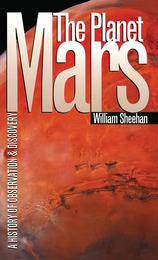
The Planet Mars
A History of Observation and Discovery
William Sheehan
University of Arizona Press, 1996
Twenty years after the Viking missions of the ’70s, we are finally going back to Mars. No fewer than ten missions are planned for the period between 1996 and 2003, and it is likely that human explorers will follow soon after--perhaps by the middle of the twenty-first century. When they do, they will owe much to the Mars of romance, to the early pioneers whose discoveries and disappointments are brought to life in The Planet Mars: A History of Observation and Discovery.
In this timely and vividly written account, William Sheehan traces human fascination with Mars back to the naked-eye observers of the planet. He recalls the early telescopic observers who first made out enigmatic markings and polar caps on its surface. Through lively historical anecdotes, he describes in detail the debate over the so-called canals of Mars, which encouraged speculation that the planet might be inhabited. Finally, Sheehan describes more recent theories about the planet, leading up to the present, when unmanned spacecraft have enabled us to make giant strides in exploration.
Well documented and sparked with human interest, this book will be a useful companion and guide in interpreting the barrage of headlines about Mars that is sure to come over the next few years. Amateurs will appreciate the contributions that have been made to Martian studies by people like themselves, and professionals will find much original material that has never before been published. The American Mars Global Surveyor is scheduled for launch in November 1996, and soon after the American Mars Pathfinder will make its way toward the red planet. A Russian mission consisting of an orbiter and two landers will be launched in October 1997. These space travelers will write a whole new chapter in the dramatic story of Mars, a planet whose exploration has only just begun. Astronomy Book Club main selection and selections of Book-of-the-Month Club and Quality Paperback Book Club.
In this timely and vividly written account, William Sheehan traces human fascination with Mars back to the naked-eye observers of the planet. He recalls the early telescopic observers who first made out enigmatic markings and polar caps on its surface. Through lively historical anecdotes, he describes in detail the debate over the so-called canals of Mars, which encouraged speculation that the planet might be inhabited. Finally, Sheehan describes more recent theories about the planet, leading up to the present, when unmanned spacecraft have enabled us to make giant strides in exploration.
Well documented and sparked with human interest, this book will be a useful companion and guide in interpreting the barrage of headlines about Mars that is sure to come over the next few years. Amateurs will appreciate the contributions that have been made to Martian studies by people like themselves, and professionals will find much original material that has never before been published. The American Mars Global Surveyor is scheduled for launch in November 1996, and soon after the American Mars Pathfinder will make its way toward the red planet. A Russian mission consisting of an orbiter and two landers will be launched in October 1997. These space travelers will write a whole new chapter in the dramatic story of Mars, a planet whose exploration has only just begun. Astronomy Book Club main selection and selections of Book-of-the-Month Club and Quality Paperback Book Club.
[more]
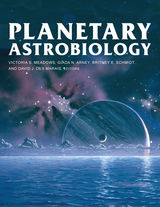
Planetary Astrobiology
Edited by Victoria S. Meadows, Giada N. Arney, Britney E. Schmidt, and David J. Des Marais
University of Arizona Press, 2020
Are we alone in the universe? How did life arise on our planet? How do we search for life beyond Earth? These profound questions excite and intrigue broad cross sections of science and society. Answering these questions is the province of the emerging, strongly interdisciplinary field of astrobiology. Life is inextricably tied to the formation, chemistry, and evolution of its host world, and multidisciplinary studies of solar system worlds can provide key insights into processes that govern planetary habitability, informing the search for life in our solar system and beyond. Planetary Astrobiology brings together current knowledge across astronomy, biology, geology, physics, chemistry, and related fields, and considers the synergies between studies of solar systems and exoplanets to identify the path needed to advance the exploration of these profound questions.
Planetary Astrobiology represents the combined efforts of more than seventy-five international experts consolidated into twenty chapters and provides an accessible, interdisciplinary gateway for new students and seasoned researchers who wish to learn more about this expanding field. Readers are brought to the frontiers of knowledge in astrobiology via results from the exploration of our own solar system and exoplanetary systems. The overarching goal of Planetary Astrobiology is to enhance and broaden the development of an interdisciplinary approach across the astrobiology, planetary science, and exoplanet communities, enabling a new era of comparative planetology that encompasses conditions and processes for the emergence, evolution, and detection of life.
Planetary Astrobiology represents the combined efforts of more than seventy-five international experts consolidated into twenty chapters and provides an accessible, interdisciplinary gateway for new students and seasoned researchers who wish to learn more about this expanding field. Readers are brought to the frontiers of knowledge in astrobiology via results from the exploration of our own solar system and exoplanetary systems. The overarching goal of Planetary Astrobiology is to enhance and broaden the development of an interdisciplinary approach across the astrobiology, planetary science, and exoplanet communities, enabling a new era of comparative planetology that encompasses conditions and processes for the emergence, evolution, and detection of life.
[more]
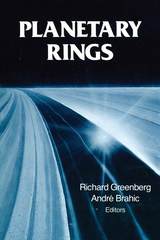
Planetary Rings
Richard Greenberg
University of Arizona Press, 1984
Published in 1985, Planetary Rings brought together scientist from a variety of disciplines to the study of planetary rings to provide a textbook for graduate students and researchers in related fields. It introduced newcomers to the subject and addressed issues at the forefront of ring research at the time.
At the time of it's publication, the editors wrote, "it is our hope that this book will become out-of-date quickly, that new observations and theoretical connections will continue to revolutionize our knowledge of planetary rings."
At the time of it's publication, the editors wrote, "it is our hope that this book will become out-of-date quickly, that new observations and theoretical connections will continue to revolutionize our knowledge of planetary rings."
[more]
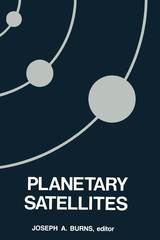
Planetary Satellites
Joseph A. Burns
University of Arizona Press, 1977
Published in 1977, this source book on natural satellites brings together thirty-four distinguished contributors from various fields of satellite astronomy to offer a thorough examination of Orbits and Dynamical Evolution.
[more]
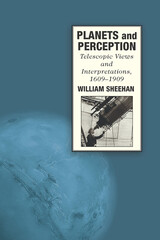
Planets and Perception
Telescopic Views and Interpretations, 1609-1909
William Sheehan
University of Arizona Press, 1988
Astronomy Book of the Year, Mercury Magazine (Astronomical Society of the Pacific)
Do we really know what we see through a telescope? How does the ocular system construct planetary images, and how does the brain interpret them? Drawing on both astronomical and psychological data, William Sheehan offers the first systematic analysis of the perceptual and cognitive factors that go into the initial structuring of a planetary image and its subsequent elaboration. Sheehan details the development of lunar and planetary astronomy, beginning with Galileo’s study of the moon, and focuses particularly on the discover of “canals” on Mars. Through each episode he underscores a perceptual or psychological theme, such as the importance of differences in vision, tachistoscopic perceptual effects, the influence of expectation and suggestion on what one sees, and the social psychology of scientific discovery. Planets and Perception is a provocative book that will intrigue anyone who has ever looked through a telescope. In addition, it offers the psychologically oriented reader a case history in the processes of perception unlike any other in the literature.
Do we really know what we see through a telescope? How does the ocular system construct planetary images, and how does the brain interpret them? Drawing on both astronomical and psychological data, William Sheehan offers the first systematic analysis of the perceptual and cognitive factors that go into the initial structuring of a planetary image and its subsequent elaboration. Sheehan details the development of lunar and planetary astronomy, beginning with Galileo’s study of the moon, and focuses particularly on the discover of “canals” on Mars. Through each episode he underscores a perceptual or psychological theme, such as the importance of differences in vision, tachistoscopic perceptual effects, the influence of expectation and suggestion on what one sees, and the social psychology of scientific discovery. Planets and Perception is a provocative book that will intrigue anyone who has ever looked through a telescope. In addition, it offers the psychologically oriented reader a case history in the processes of perception unlike any other in the literature.
[more]
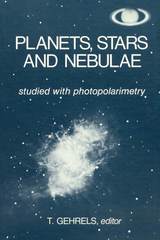
Planets, Stars and Nebulae Studied with Photopolarimetry
Edited by T. Gehrels
University of Arizona Press, 1974
“The polarization study of celestial objects is a valuable part of optical astronomy, and the author has done exceptionally well in bringing together contributions treating all aspects of the polarimetry field. . . . The first section contains a fine introduction and an excellent and definitive history of the subject. . . . The volume is well illustrated. . . . Highly recommended.”—Choice
“The high quality of this book is clearly due to strict editorial attention to each paper and the discussions. Gehrels’s book will surely stand for many years as the fundamental reference source for polarization studies in astronomy as well as in atmospheric physics.”—Journal of the Association of Lunar and Planetary Observers
“The high quality of this book is clearly due to strict editorial attention to each paper and the discussions. Gehrels’s book will surely stand for many years as the fundamental reference source for polarization studies in astronomy as well as in atmospheric physics.”—Journal of the Association of Lunar and Planetary Observers
[more]
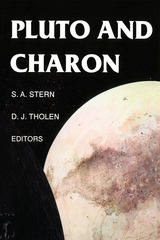
Pluto and Charon
Edited by S. A. Stern and D. J. Tholen
University of Arizona Press, 1997
For five decades after its discovery in 1930, the planet Pluto remained an enigma. However, several events during the last two decades have helped to lift the veil of mystery surrounding the ninth planet. The discovery of its satellite, Charon, in 1978 permitted occultation observations that allowed scientists to determine the size of both bodies. Astronomers also detected the presence of an atmosphere, and the Hubble Space Telescope provided views in unprecedented detail. In addition to these two fortuitous events, advances in telescopic instrumentation and computational methods led to exciting observational and theoretical discoveries. This new Space Sciences Series volume focuses on the scientific issues associated with Pluto and Charon. Fifty collaborating authors here review the latest research on the Pluto-Charon binary, from bulk properties, surfaces and interiors to atmospheric structure, composition, and dynamics. They also provide historical perspectives on Pluto-Charon research and discuss the population of the trans-Neptunian region and the origin of the Pluto-Charon binary. Also included are prefatory remarks by Pluto's and Charon's discoverers, Clyde Tombaugh and James Christy. This volume offers the most comprehensive available compendium of research work for understanding these far off members of our solar system, just at a time following dramatic developments in our knowledge but before that knowledge can be advanced by spacecraft missions.
[more]
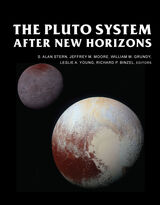
The Pluto System After New Horizons
S. Alan Stern, Jeffrey M. Moore, William M. Grundy, Leslie A. Young, Richard P. Binzel, Editors
University of Arizona Press, 2021
Once perceived as distant, cold, dark, and seemingly unknowable, Pluto had long been marked as the farthest and most unreachable frontier for solar system exploration. After Voyager accomplished its final planetary reconnaissance at Neptune in 1989, Pluto and its cohort in the Kuiper Belt beckoned as the missing puzzle piece for completing the first reconnaissance of our solar system. In the decades following Voyager, a mission to the Pluto system was not only imagined but also achieved, culminating with the historic 2015 flyby by the New Horizons spacecraft. Pluto and its satellite system (“the Pluto system”), including its largest moon, Charon, have been revealed to be worlds of enormous complexity that fantastically exceed preconceptions.
The Pluto System After New Horizons seeks to become the benchmark for synthesizing our understanding of the Pluto system. The volume’s lead editor is S. Alan Stern, who also serves as NASA’s New Horizons Principal Investigator; co-editors Richard P. Binzel, William M. Grundy, Jeffrey M. Moore, and Leslie A. Young are all co-investigators on New Horizons. Leading researchers from around the globe have spent the last five years assimilating Pluto system flyby data returned from New Horizons. The chapters in this volume form an enduring foundation for ongoing study and understanding of the Pluto system. The volume also advances insights into the nature of dwarf planets and Kuiper Belt objects, providing a cornerstone for planning new missions that may return to the Pluto system and explore others of the myriad important worlds beyond Neptune.
The Pluto System After New Horizons seeks to become the benchmark for synthesizing our understanding of the Pluto system. The volume’s lead editor is S. Alan Stern, who also serves as NASA’s New Horizons Principal Investigator; co-editors Richard P. Binzel, William M. Grundy, Jeffrey M. Moore, and Leslie A. Young are all co-investigators on New Horizons. Leading researchers from around the globe have spent the last five years assimilating Pluto system flyby data returned from New Horizons. The chapters in this volume form an enduring foundation for ongoing study and understanding of the Pluto system. The volume also advances insights into the nature of dwarf planets and Kuiper Belt objects, providing a cornerstone for planning new missions that may return to the Pluto system and explore others of the myriad important worlds beyond Neptune.
[more]

Practical Mystic
Religion, Science, and A. S. Eddington
Matthew Stanley
University of Chicago Press, 2007
Science and religion have long been thought incompatible. But nowhere has this apparent contradiction been more fully resolved than in the figure of A. S. Eddington (1882–1944), a pioneer in astrophysics, relativity, and the popularization of science, and a devout Quaker. Practical Mystic uses the figure of Eddington to shows how religious and scientific values can interact and overlap without compromising the integrity of either.
Eddington was a world-class scientist who not only maintained his religious belief throughout his scientific career but also defended the interrelation of science and religion while drawing inspiration from both for his practices. For instance, at a time when a strict adherence to deductive principles of physics had proved fruitless for understanding the nature of stars, insights from Quaker mysticism led Eddington to argue that an outlook less concerned with certainty and more concerned with further exploration was necessary to overcome the obstacles of incomplete and uncertain knowledge.
By examining this intersection between liberal religion and astrophysics, Practical Mystic questions many common assumptions about the relationship between science and spirituality. Matthew Stanley’s analysis of Eddington’s personal convictions also reveals much about the practice, production, and dissemination of scientific knowledge at the beginning of the twentieth century.
Eddington was a world-class scientist who not only maintained his religious belief throughout his scientific career but also defended the interrelation of science and religion while drawing inspiration from both for his practices. For instance, at a time when a strict adherence to deductive principles of physics had proved fruitless for understanding the nature of stars, insights from Quaker mysticism led Eddington to argue that an outlook less concerned with certainty and more concerned with further exploration was necessary to overcome the obstacles of incomplete and uncertain knowledge.
By examining this intersection between liberal religion and astrophysics, Practical Mystic questions many common assumptions about the relationship between science and spirituality. Matthew Stanley’s analysis of Eddington’s personal convictions also reveals much about the practice, production, and dissemination of scientific knowledge at the beginning of the twentieth century.
[more]
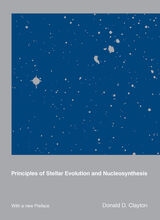
Principles of Stellar Evolution and Nucleosynthesis
Donald D. Clayton
University of Chicago Press, 1984
Donald D. Clayton's Principles of Stellar Evolution and Nucleosynthesis remains the standard work on the subject, a popular textbook for students in astronomy and astrophysics and a rich sourcebook for researchers. The basic principles of physics as they apply to the origin and evolution of stars and physical processes of the stellar interior are thoroughly and systematically set out. Clayton's new preface, which includes commentary and selected references to the recent literature, reviews the most important research carried out since the book's original publication in 1968.
[more]

Protostars and Planets
Tom Gehrels
University of Arizona Press, 1979
Originally published in 1979, at the time of it's publication this work was a unique source book on star formation and the origin of planetary systems from some 35 distinguished authors. Topics include the formation of stars from the cloudy to the stellar to the planetary state. Special emphasis on stars believed capable of producing planets. This foundational work sought to define a new discipline and set the course for the University of Arizona Space Science series.
[more]
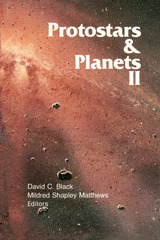
Protostars and Planets II
David C. Black
University of Arizona Press, 1985
Based on meetings held in Tucson, Arizona in 1984, this volume brought up-to-date recent advances and research on the cosmogony of stars and planets. This book presents the written thoughts of the principle speakers (and their colleagues) from the 1984 meeting. This work continued work started in 1978 to investigate the problems of star formation and the formation of the solar system.
[more]
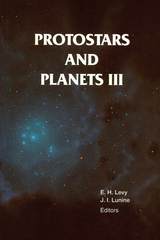
Protostars and Planets III
Eugene Levy
University of Arizona Press, 1993
Previous Space Science Series volumes Protostars and Planets (1978) and Protostars and Planets II (1985) were among the most timely offerings of this illustrious collection of technical works. Protostars and Planets III continues to address fundamental questions concerning the formation of stars and planetary systems in general and of our solar system in particular. Drawing from advances in observational, experimental, and theoretical research, it summarizes our understanding of these processes and addresses major open questions and research issues. Among the more notable subjects covered in the more than three dozen chapters are the collapse of clouds and the formation and evolution of stars and disks; nucleosynthesis and star formation; the occurrence and properties of disks around young stars; T Tauri stars and their accretion disks; gaseous accretion and the formation of the giant planets; comets and the origin of the Solar-System; and the long-term dynamical evolution and stability of the solar system.
Protostars and Planets III reflects the enormous progress made in understanding star and planet formation as a result of new observational capabilities and cooperative research among scientists from diverse fields.
Protostars and Planets III reflects the enormous progress made in understanding star and planet formation as a result of new observational capabilities and cooperative research among scientists from diverse fields.
[more]
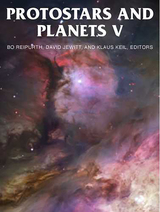
Protostars and Planets V
Edited by Bo Reipurth, David Jewitt, and Klaus Keil
University of Arizona Press, 2007
Increasing discoveries of new planets beyond our solar system are invigorating the quest for new knowledge and understanding of the birth of stars and planets. This new volume in the Space Science Series, with 249 contributing authors, builds on the latest results from recent advances in ground and space-based astronomy and in numerical computing techniques to offer the most detailed and up-to-date picture of star and planet formation, including the formation of our own solar system. This book emphasizes the cross-disciplinary aspects of the field, with a particular focus on the early evolution of our solar system. Protostars and Planets V is the new foundation for further advancement in the fields of stellar and planetary formation, making it an indispensable resource for researchers and students in astronomy, planetary science, and the study of meteorites.
[more]
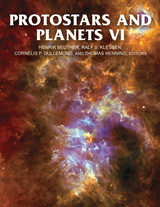
Protostars and Planets VI
Edited by Henrik Beuther, Ralf S. Klessen, Cornelis P. Dullemond, and Thomas Henning
University of Arizona Press, 2014
The revolutionary discovery of thousands of confirmed and candidate planets beyond the solar system brings forth the most fundamental
question: How do planets and their host stars form and evolve? Protostars and Planets VI brings together more than 250 contributing authors at the forefront of their field, conveying the latest results in this research area and establishing a new foundation for advancing our understanding of stellar and planetary formation.
Continuing the tradition of the Protostars and Planets series, this latest volume uniquely integrates the cross-disciplinary aspects of this broad field. Covering an extremely wide range of scales, from the formation of large clouds in our Milky Way galaxy down to small chondrules in our solar system, Protostars and Planets VI takes an encompassing view with the goal of not only highlighting what we know but, most importantly, emphasizing the frontiers of what we do not know.
As a vehicle for propelling forward new discoveries on stars, planets, and their origins, this latest volume in the Space Science Series is an indispensable resource for both current scientists and new students in astronomy, astrophysics, planetary science, and the study of meteorites.
question: How do planets and their host stars form and evolve? Protostars and Planets VI brings together more than 250 contributing authors at the forefront of their field, conveying the latest results in this research area and establishing a new foundation for advancing our understanding of stellar and planetary formation.
Continuing the tradition of the Protostars and Planets series, this latest volume uniquely integrates the cross-disciplinary aspects of this broad field. Covering an extremely wide range of scales, from the formation of large clouds in our Milky Way galaxy down to small chondrules in our solar system, Protostars and Planets VI takes an encompassing view with the goal of not only highlighting what we know but, most importantly, emphasizing the frontiers of what we do not know.
As a vehicle for propelling forward new discoveries on stars, planets, and their origins, this latest volume in the Space Science Series is an indispensable resource for both current scientists and new students in astronomy, astrophysics, planetary science, and the study of meteorites.
[more]
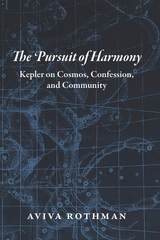
The Pursuit of Harmony
Kepler on Cosmos, Confession, and Community
Aviva Rothman
University of Chicago Press, 2017
A committed Lutheran excommunicated from his own church, a friend to Catholics and Calvinists alike, a layman who called himself a “priest of God,” a Copernican in a world where Ptolemy still reigned, a man who argued at the same time for the superiority of one truth and the need for many truths to coexist—German astronomer Johannes Kepler was, to say the least, a complicated figure. With The Pursuit of Harmony, Aviva Rothman offers a new view of him and his achievements, one that presents them as a story of Kepler’s attempts to bring different, even opposing ideas and circumstances into harmony.
Harmony, Rothman shows, was both the intellectual bedrock for and the primary goal of Kepler’s disparate endeavors. But it was also an elusive goal amid the deteriorating conditions of his world, as the political order crumbled and religious war raged. In the face of that devastation, Kepler’s hopes for his theories changed: whereas he had originally looked for a unifying approach to truth, he began instead to emphasize harmony as the peaceful coexistence of different views, one that could be fueled by the fundamentally nonpartisan discipline of mathematics.
Harmony, Rothman shows, was both the intellectual bedrock for and the primary goal of Kepler’s disparate endeavors. But it was also an elusive goal amid the deteriorating conditions of his world, as the political order crumbled and religious war raged. In the face of that devastation, Kepler’s hopes for his theories changed: whereas he had originally looked for a unifying approach to truth, he began instead to emphasize harmony as the peaceful coexistence of different views, one that could be fueled by the fundamentally nonpartisan discipline of mathematics.
[more]
READERS
Browse our collection.
PUBLISHERS
See BiblioVault's publisher services.
STUDENT SERVICES
Files for college accessibility offices.
UChicago Accessibility Resources
home | accessibility | search | about | contact us
BiblioVault ® 2001 - 2024
The University of Chicago Press









